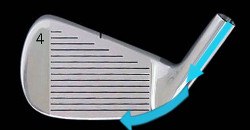
The Golf Term: Lie Angle
The golf term “lie angle” refers to the angle formed between the sole of the golf club and the shaft. It is an important aspect of club fitting as it greatly affects the direction and accuracy of your shots. Understanding and optimizing the lie angle of your clubs can significantly improve your performance on the course. Here's everything you need to know about lie angle:
Importance of Lie Angle
The lie angle of a golf club determines how the clubhead interacts with the ground at impact. A proper lie angle ensures that the sole of the club is resting evenly on the ground, allowing the clubface to be square to the target line. This square face alignment is crucial for hitting straight shots consistently.
Incorrect lie angles can lead to two major shot tendencies:
- Toe Up: If the lie angle is too upright (the clubhead is too vertical), the toe of the club tends to be elevated at impact. This can result in pushes or fades as the clubface opens up.
- Toe Down: Conversely, if the lie angle is too flat (the clubhead is too horizontal), the toe of the club points downward at impact. This can lead to hooks or draws as the clubface closes.
Determining the Correct Lie Angle
Finding the correct lie angle for your clubs requires a club fitting session with a professional. During the fitting, the fitter analyzes your swing and impact dynamics to determine the appropriate lie angle that matches your swing.
Factors that influence the optimal lie angle for each golfer include:
- Height and Posture: Taller golfers generally require more upright lie angles, while shorter golfers may need flatter ones. Your posture at address also plays a role.
- Swing Plane: The angle at which your club swings influences the lie angle. Depending on your swing plane, the fitter can adjust the lie angle to help you achieve better contact.
- Impact Position: If you consistently strike the ball toward the heel or toe, adjustments to the lie angle can assist in centering impact for improved consistency.
Effects of Incorrect Lie Angle
Using clubs with incorrect lie angles can lead to several negative consequences:
- Consistent directional misses
- Loss of distance
- Inconsistent ball striking
- Inaccurate shot shaping
- Discomfort or injury due to compensations in swing mechanics
Adjusting Lie Angle
If you find that your clubs have incorrect lie angles, a professional club fitter can make adjustments for you. They can bend the clubhead slightly to either make it more upright or flatter, based on your requirements. It's important to note that lie angle adjustments require precision and should be performed by an experienced fitter or club technician.
Remember, having the correct lie angle in your golf clubs is crucial for consistent and accurate shots. A club fitting session can help determine the right lie angle for you and improve your overall performance on the course.+





